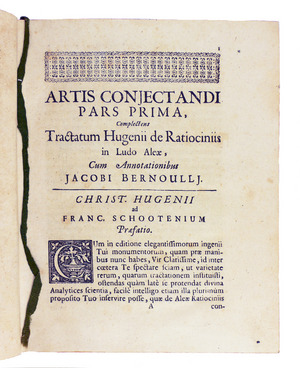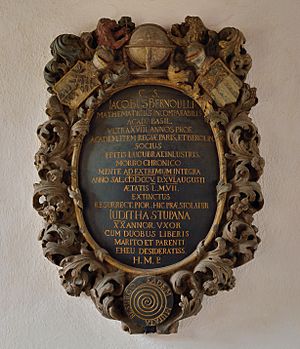Jacob Bernoulli facts for kids
Quick facts for kids
Jacob Bernoulli
|
|
|---|---|
 |
|
| Born | 6 January 1655 Basel, Switzerland
|
| Died | 16 August 1705 (aged 50) Basel, Switzerland
|
| Education | University of Basel (D.Th., 1676; Dr. phil. hab., 1684) |
| Known for | Bernoulli differential equation Bernoulli numbers Bernoulli's formula Bernoulli polynomials Bernoulli map Bernoulli trial Bernoulli process Bernoulli scheme Bernoulli operator Hidden Bernoulli model Bernoulli sampling Bernoulli distribution Bernoulli random variable Bernoulli's Golden Theorem Bernoulli's inequality Lemniscate of Bernoulli |
| Scientific career | |
| Fields | Mathematics, mechanics |
| Institutions | University of Basel |
| Theses |
|
| Doctoral advisor | Peter Werenfels (1676 thesis advisor) |
| Other academic advisors | Gottfried Wilhelm Leibniz (epistolary correspondent) |
| Doctoral students | Jacob Hermann Nicolaus I Bernoulli |
| Other notable students | Johann Bernoulli |
| Influences | Nicolas Malebranche |
| Notes | |
|
Brother of Johann Bernoulli
|
|
Jacob Bernoulli (also known as James or Jacques; 6 January 1655 – 16 August 1705) was a very important mathematician. He was part of the famous Bernoulli family, which had many brilliant scientists.
Jacob was one of the first to use and support calculus, a new type of math developed by Gottfried Leibniz. He also helped create a field called the calculus of variations. He even discovered the important mathematical constant e.
His biggest contribution was in probability. He came up with the first version of the law of large numbers. This idea explains how the average results of many tries will get closer to the expected value. He wrote about this in his book Ars Conjectandi.
Contents
Biography of Jacob Bernoulli
Jacob Bernoulli was born in Basel, Switzerland. His father wanted him to study theology and become a minister. But Jacob was more interested in mathematics and astronomy. He studied these subjects on his own.
From 1676 to 1682, he traveled around Europe. He learned about the newest discoveries in math and science. He met famous thinkers like Robert Boyle. During this time, he also wrote a theory about comets, but it turned out to be incorrect.
Jacob returned to Switzerland and started teaching mechanics. This was at the University of Basel in 1683. He finished his doctoral paper in 1684, and it was published in 1687.
In 1684, Jacob married Judith Stupanus. They had two children together. Around this time, he also started his important research work. His travels helped him connect with many leading mathematicians. He kept in touch with them throughout his life.
He studied new math ideas, including works by Christiaan Huygens and René Descartes. He also became very interested in infinitesimal geometry. Many of the ideas for his famous book Ars Conjectandi came from his studies during these years.
In 1687, he became a professor of mathematics at the University of Basel. He stayed in this job for the rest of his life. He also started teaching his younger brother, Johann Bernoulli, about math.
The two brothers began studying calculus together. This was a very new and complex area of math. They were among the first to truly understand and use Gottfried Leibniz's ideas on calculus.
Jacob and Johann worked together on many calculus problems. However, their teamwork soon turned into a rivalry. Johann became a brilliant mathematician himself. They started arguing in their published works. They even challenged each other with difficult math problems. By 1697, their relationship had completely broken down.
The lunar crater Bernoulli on the Moon is named after both Jacob and his brother Johann.
Jacob Bernoulli's Important Works
Jacob Bernoulli's first major contributions were in logic and algebra in 1685. He also worked on probability and geometry. In geometry, he found a way to divide any triangle into four equal parts using two straight lines.
By 1689, he had published important work on infinite series. He also published his law of large numbers in probability theory. He wrote five papers on infinite series between 1682 and 1704.
He showed that a specific infinite series, called the harmonic series, keeps growing without limit. He also studied another series that adds up to a finite number. Later, Leonhard Euler found the exact value of this sum.
In 1690, Jacob Bernoulli solved a problem about the isochrone. This is a special curve where an object slides down in the same amount of time, no matter where it starts. He solved this by using a type of math problem called a differential equation. This paper was important because it was the first time the word "integral" was used with its modern meaning in calculus.
In 1696, he solved a specific type of equation. Today, this is known as the Bernoulli differential equation.
Jacob Bernoulli also found a way to figure out the evolutes of a curve. He also looked into caustic curves, which are curves formed by light rays. In 1694, he created the lemniscate of Bernoulli, a figure-eight shaped curve. In 1695, he studied the "drawbridge problem." This problem looks for the perfect curve for a cable to keep a drawbridge balanced.
Bernoulli's most famous work is Ars Conjectandi. It was published in 1713, eight years after he died. The book was not fully finished, but it is still very important for the theory of probability.
The book also covers other topics. These include combinatorics, which is about counting different ways things can be arranged. It also talks about Bernoulli numbers. Inspired by Christiaan Huygens, Bernoulli gave many examples of how much one might expect to win in different games of chance. The term Bernoulli trial comes from this book.
In the last part of Ars Conjectandi, Bernoulli explored many ideas in probability. He discussed probability as a way to measure how certain something is. He also wrote about the law of large numbers. This law says that if you repeat an experiment many times, the average result will get closer to the expected outcome.
Jacob Bernoulli was a key person in developing advanced math methods. His work was always honest and thorough.
Discovery of the Mathematical Constant e
In 1683, Bernoulli discovered the mathematical constant e. He found it while studying a question about compound interest. He wanted to know what happens when interest is added more and more often.
Imagine you have $1.00 and it earns 100% interest per year.
- If the interest is added once at the end of the year, you get $2.00.
- If it's added twice a year (50% each time), you get $1.00 × 1.5 × 1.5 = $2.25.
- If it's added four times a year (25% each time), you get $1.00 × 1.25 × 1.25 × 1.25 × 1.25 = $2.44.
Bernoulli noticed that as the interest was added more and more often, the total amount got closer to a specific number. This number is e. If interest is added continuously, the $1.00 would grow to about $2.71828. This constant e is now used in many areas of math and science.
Jacob Bernoulli's Tombstone
Jacob Bernoulli wanted a logarithmic spiral carved on his tombstone. He also wanted the motto Eadem mutata resurgo, which means 'Although changed, I rise again the same'.
He believed the spiral, which looks the same no matter how much you zoom in or out, was a symbol. It could mean strength and steadiness in hard times. Or it could represent the human body, which changes but will be restored even after death.
Bernoulli died in 1705. However, the spiral carved on his tombstone was an Archimedean spiral, not the logarithmic one he wanted.
The Latin words on his tombstone translate to:
- Jacob Bernoulli, the amazing mathematician.
- Professor at the University of Basel for over 18 years.
- Member of the Royal Academies of Paris and Berlin; famous for his writings.
- He suffered from a long illness, but his mind was clear until the end.
- He passed away in the year 1705, on August 16th, at the age of 50 years and 7 months, waiting for resurrection.
- Judith Stupanus, his wife of 20 years, and his two children put up this monument for the husband and father they missed so much.
Works by Jacob Bernoulli
- (in la) Conamen novi systematis cometarum. Amstelaedami: apud Henr. Wetstenium. 1682. https://gutenberg.beic.it/webclient/DeliveryManager?pid=17384&custom_att_2=simple_viewer&search_terms=DTL4&pds_handle=. (A new idea for the system of comets)
- (in la) De gravitate aetheris. Amstelaedami: apud Henricum Wetstenium. 1683. https://gutenberg.beic.it/webclient/DeliveryManager?pid=1216514&custom_att_2=simple_viewer&search_terms=DTL5&pds_handle=.
- Ars conjectandi, opus posthumum, Basileae, impensis Thurnisiorum Fratrum, 1713. (The Art of Conjecturing, a work published after his death)
- (in la) Opera. 1. Genève: héritiers Cramer & frères Philibert. 1744. https://gutenberg.beic.it/webclient/DeliveryManager?pid=12199963. (Collected Works, Volume 1)
- (in la) Opera. 2. Genève: héritiers Cramer & frères Philibert. 1744. https://gutenberg.beic.it/webclient/DeliveryManager?pid=12202240. (Collected Works, Volume 2)
Images for kids
See also
 In Spanish: Jakob Bernoulli para niños
In Spanish: Jakob Bernoulli para niños






